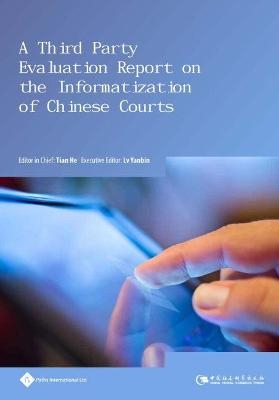
A Third Party Evaluation Report on the Informatization of Chinese Courts
Paths Publishing Group (Verlag)
978-1-84464-555-8 (ISBN)
Since the 1990s, global science and technology has been progressing every single day, with internet and big data having become an important orientation of the times and the most significant characteristics of the global economic society as well. Therefore promoting information development is becoming not only a top concern of the state, but a demanded work for the court. The informatisation of courts is defined as an endeavor and process in which the courts take initiatives to upgrade judicial credibility and to uphold legal justice by developing and implementing various types of information systems utilizing information technology in their collection, processing, storage, sharing and exploration of all kinds of information emerging from trials for promoting judicial transparency and justice for the people to the public, and for standardizing the exercise of internal judicial power and improving both the quality and efficiency of court performance.
Being an important component of the state informatization, the court informatization is undergoing a profound self-revolution within the judicial system, which is not only transforming the trial mode, but improving judicial capability and optimizing the judicial structure for the construction of an innovative trial mode. And at the same time it serves as an important means to provide better services for the public and to realize the fundamental goal of justice for the people. Therefore, the development of the court information is a key solution for the court to tackle a series of deep-level issues such as how to better achieve social fairness and justice and how to meet the judicial needs of the public in the New Era, being itself an important part of the judicial reform. Recent years have witnessed remarkable achievements in judicial transparency, justice for the people, and the betterment of trial quality and efficiency as well as the standardization of judicial administration, as a result of the great initiatives by the Chinese courts in their construction of the court information network under the guidance of the overall strategy for ruling the country by law, and in accordance with the idea of “Big data, large scale, great service” while striving to provide good services for the people, trial, and judicial administration.
He Tian Research Fellow, Institute of Law, Chinese Academy of Social Sciences; lead Researcher of the Innovation Project on the Rule of Law Index and director of the Center for the Study of National Index of the Rule of Law, Institute of Law, Chinese Academy of Social Sciences.
1. The theoretical foundation and practical significance of court informatization
1.1 The theoretical foundation
1.1.1 Need for facilities
1.1.2 Orientation of services
1.1.3 Construction costs
1.1.4 System risks
1.1.5 External circumstances
1.2 The practical significance
1.2.1 Serving the people and safeguarding judicial justice
1.2.2 Reinforcing judicial transparency and standardizing power enforcement
1.2.3 Optimizing judicial administration and enhancing trial quality and efficiency
1.2.4 Adapting to social changes and serving the state strategy
2. Achievements in the court informatization construction
2.1 A full coverage of courts in a rapid network construction
2.1.1 Information networks for trials and administrations at the Supreme People’s Court
2.1.2 Information management platforms at the local courts
2.2 Judiciary Measure innovations to serve the people
2.2.1 People enjoy “less running about, less spending, and less trouble”
2.2.2 No more “hard to be served” and “hard to be interviewed”
2.2.3 Keeping clear the passage for the public interest demands and complaint articulation
2.2.4 “Legal services delivered to the door”
2.2.5 Keeping a “micro” distance in the aid of new media with the people
2.3 Informatization assisting in the modernization of trial capability
2.3.1 Constructing technological courtrooms
2.3.2 Implementing long-distance video system
2.3.3 Electronic courts online
2.3.4 The court e-stamp and e-signature
2.4 Significant enhancement of the court enforcement capability and effective credit corrections
2.4.1 Current construction and working of the information management system at the Supreme People’s Court
2.4.2 Current construction and working of the information management system at the local courts of various levels
2.5 Precise management of trials and dynamic monitoring of their working
2.5.1 Enhancing the trial and enforcement quality and efficiency
2.5.2 Providing smart services for the judges
2.5.3 Optimizing and reconstructing the procedure of trial and enforcement
2.5.4 Monitoring the situation and serving the trial and enforcement
2.6 Deepening judicial openness and contributing to the reinforcement of the court public credibility
2.6.1 Informatization promoting open trial process
2.6.2 Informatization facilitating open ruling documents
2.6.3 Informatization deepening open enforcement information
2.7 The judicial reform gaining its momentum by information technology
2.7.1 Informatization promoting the reform of trial and enforcement
2.7.2 Informatization boosting reforming judicial management
2.8 Concentrating big data to enhance governance
2.8.1 Accomplishments in concentrated management of judicial information
2.8.2 Big data in service of socioeconomic construction
2.9 Boosting the construction of honest and clean courts and supervising judicial power exercising
2.9.1 An application system for discipline inspection and supervision
2.9.2 Easy access of complaints and reporting
2.9.3 Improving the internal supervision and monitoring system
2.10 Information construction in steady progress and the guarantee mechanism in constant improvement
2.10.1 Organization leadership and team construction
2.10.2 Maintenance guarantee and information safety
3. The direction of future work
3.1 Upgrading conception and revolutionizing the judicial system with Informatization
3.2 Making top-level design for an overall coordinated advancement of the court information system
3.3 Mastering judicial regularities for an in-depth coalescence of IT and court operations
3.4 Balancing supply and demand and assisting in trial enforcement in service of the people
3.5 Improving data analysis and serviceability for a better service to socioeconomic development
3.6 Strengthening team construction for training and exchange of excellent specialists in the court information Concluding remarks
Appendixes 1: A list of the official documents for the informatization of the country-wide courts
Appendixes 2: A Five-Year Development Plan for the Construction of the Information System of the People’s Courts (2016-2020)
| Erscheinungsdatum | 08.08.2019 |
|---|---|
| Mitarbeit |
Chef-Herausgeber: Tian He, Yanbin Lv |
| Sprache | englisch |
| Maße | 175 x 251 mm |
| Gewicht | 386 g |
| Themenwelt | Geschichte ► Teilgebiete der Geschichte ► Militärgeschichte |
| Mathematik / Informatik ► Informatik | |
| Recht / Steuern ► EU / Internationales Recht | |
| Recht / Steuern ► Öffentliches Recht | |
| Recht / Steuern ► Privatrecht / Bürgerliches Recht ► Berufs-/Gebührenrecht | |
| Recht / Steuern ► Rechtsgeschichte | |
| ISBN-10 | 1-84464-555-X / 184464555X |
| ISBN-13 | 978-1-84464-555-8 / 9781844645558 |
| Zustand | Neuware |
| Haben Sie eine Frage zum Produkt? |
aus dem Bereich


